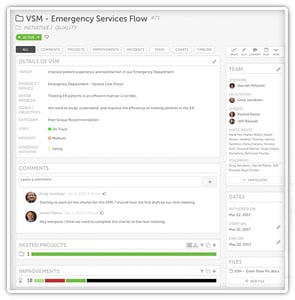 After many years of speaking with leaders and managers looking to implement process improvement tools in their organizations, we've learned a few things. The first is that every organization is different and what scores a home run for one may not even get a hit in another. The second is that despite these differences, many of the process improvement tools that have been developed over the last 50 years can be adapted to be useful for organizations of all types and sizes.
After many years of speaking with leaders and managers looking to implement process improvement tools in their organizations, we've learned a few things. The first is that every organization is different and what scores a home run for one may not even get a hit in another. The second is that despite these differences, many of the process improvement tools that have been developed over the last 50 years can be adapted to be useful for organizations of all types and sizes.
This post provides a brief introduction to some of the process improvement tools that our customers have used to reduce costs, improve safety, assure quality, and increase customer satisfaction. For each tool or idea, we've included a link to more detailed information. Many are borrowed from the Lean and Six Sigma methodologies, but you don't have to be using one of them to find value in these techniques.
#1 - A3 Thinking and Management
A3 is a structured problem-solving technique that Toyota first developed. It gets its name from the final report that is one page (A3 is a standard European paper size) that documents the results from the PDCA cycle. Forcing the information to be condensed to one page helps teams focus on what's important.
An A3 Report includes sections that define the problem and map existing processes. It also describes the desired future state and the proposed process changes. Once the changes are implemented, the results are also included in the report.
#2 - 5S (Sort, Set, Shine, Standardize, Sustain)
5S is the name of a workplace organization method based on the Japanese words: seiri (sort), seiton (set), seiso (shine), seiketsu (standardize), and shitsuke (sustain). The approach was developed in the manufacturing sector as a way of maintaining efficiency and safety, but workplace setup is essential in several industries, including healthcare, construction, and education.
When workers have a space that is ordered and consistent, they are in a better position to do their best work and keep waste to a minimum.
#4 Catchball
Catchball is a tool borrowed from the strategy deployment approach in Lean manufacturing. It is simply the process of moving ideas from person to person, up and down the org chart, to define the purpose, goals, and challenges of each improvement project. Then, each stakeholder provides input and feedback until a plan for improvement evolves and is implemented.
#5 Control Charts
The use of control charts is widespread in manufacturing, but they can be of value in almost every sector. Data is visualized overtime on a chart that displays upper and lower control limits. Displaying the data this way makes it easy for managers to discern between common cause variation that is no reason for alarm and special cause variation, which may require immediate attention.
#6 DMAIC (Define, Measure, Analyze, Improve, Control)
DMAIC is an improvement cycle that uses five phases to structure the project. DMAIC, which stands for define, measure, analyze, improve and control, helps ensure that each improvement decision is based on data, that results are measurable, and that success can be sustained.
#7 Gemba Walks
Gemba means “the real place” in Japanese. During a Gemba walk, managers or supervisors go to the workplace to observe and identify opportunities for improvement. The workplace may be a factory floor, a construction site, a classroom, or an office. The manager asks questions, observes processes, and documents what they find. Then, after a period of reflection, opportunities for improvement are documented and may be implemented.
#8 Hoshin Kanri (Policy Deployment)
Hoshin Kanri is a strategic planning tool that ensures everyone in an organization is driving toward the same goals, often called "true north." It helps leaders balance the need to achieve long-term goals and to address daily improvement opportunities at the same time.
Goals cascade down from the critical strategic initiatives to individual objectives and responsibilities. Critically, these goals are frequently discussed and provide the basis for decision-making at every level.
#9 Kanban and Kanban Boards
Kanban is a visual process mapping tool for displaying the state of work in progress to maximize the flow of goods and work. When the state of work is made visible, leaders can quickly see interruptions inflow and bottlenecks that cause waste. Kanban can be implemented with cards like those used by Toyota to manage inventory, or Kanban boards can be used for visualizing other types of work.

#10 PDSA Cycle (Plan, Do, Study, Act)
The PDSA Cycle is also known as the Deming Cycle. It is a repeated cycle that is applied to an opportunity for improvement. It is a simple yet powerful way to ensure that fixes to problems aren't implemented without due analysis and documentation. Once the cycle is complete, it begins again with a new plan for improvement.
#11 Standard Work
Standard work represents the current best practices for any process or task. It forms the basis for the PDSA or DMAIC improvement cycle. Therefore, the Standard work documentation must be complete, accessible, and up to date.
Standard work is the foundation of almost all improvement work. It should be crafted by the people who operate the process. It is important to consider standard work the basis for improvement rather than dictating how operations will proceed forever.
#12 The 5 Whys
The 5 Whys Whys is a cause-and-effect analysis tool for finding the root source of an issue. It starts with a statement of the problem, followed by the question of why. The question of why again follows that answer and the process is repeated until the root cause of the problem is revealed. Effective corrective action can then be applied.
#13 Value Stream Mapping (VSM)
Value Stream Mapping is a structured process mapping method for documenting and analyzing each step of the flow of value to the customer. Visualizing the value stream helps leaders identify and eliminate waste within the stream. It can be applied to an individual process or used more systemically.
When it comes to process improvement tools, you have a bunch of choices. You might not use every one each day, but you may want to bookmark this post and come back to it when you are deciding how to tackle a particular opportunity for improvement.
![[Watch Now] Cascading Strategy Through Hoshin Kanri](https://no-cache.hubspot.com/cta/default/326641/dd5ad176-fb74-4e1e-bf28-ff4d966d1701.png)

![[WEBINAR] Strategy Deployment Software Demo](https://no-cache.hubspot.com/cta/default/326641/67b72769-975a-48b1-b5d8-4ba0fe1f3b76.png)


Add a Comment